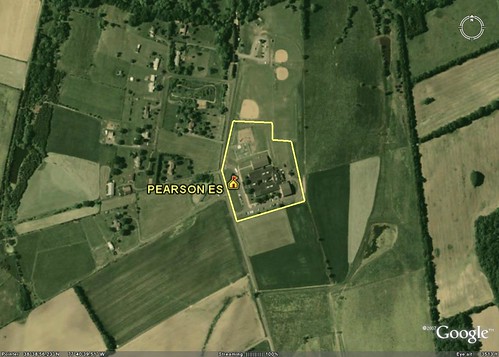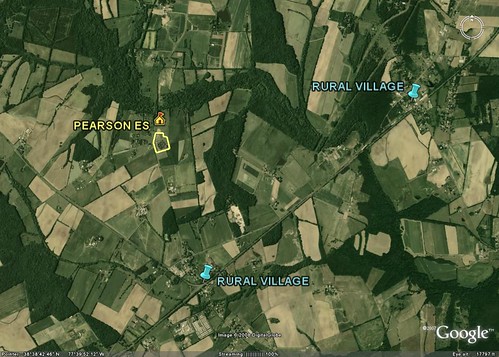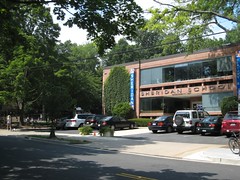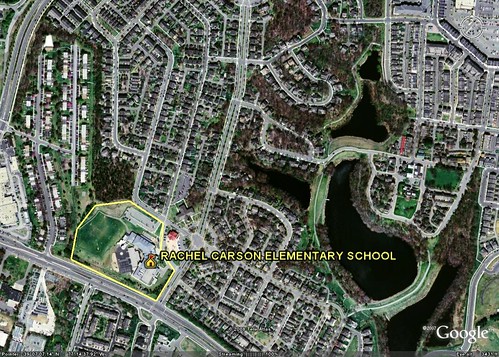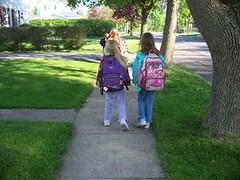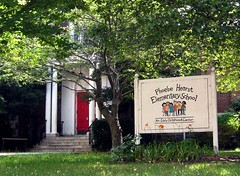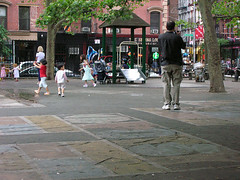A photo essay on school sprawl (part 2)

Posted September 19, 2008 at 1:49PM
When I left off yesterday, I showed a Google Earth image of an elementary school set on a lot isolated from its nearby community, some of whose kids might otherwise walk to school. Here's one that's even more isolated:
For reasons unrelated to work, I've visited Pearson Elementary, which one of my friends calls "the school in the cornfield." But it's a rural area, you might be thinking, and it's unrealistic to expect an urban neighborhood setting.
I have to agree, but only to a point. There are towns not that far away. Even closer are some rural villages that would have made much better candidates for a school location. Here's essentially the same satellite image, but zoomed out to show more of the surrounding area:
If the school were in one of those alternate locations, neither of which has its own school, at least some kids could walk, and it would be more convenient for other members of the community to use the facilities for recreation or other functions that schools frequently host. My guess is that the school is where it is only because that just happened to be the parcel that became available at the right time, for the price the school board was willing to pay.
Enough of the bad stuff. Here are some elementary schools that fit right into their neighborhoods. One is older, one newer, one public, one private, but they both are truly community-serving. Although they happen to be in residential parts of DC, their architecture, setting and scale could place them in almost any kind of neighborhood except one that is highly rural or a highly urban downtown:
Here's the satellite view of the neighborhood near the Sheridan School, the one on the right above, so you can see how well it fits into the community fabric and how many kids are potentially within convenient walking distance:
But what about a school in a new suburb? Isn't it much harder to do in the right way? Well, yes, in part because of the policies highlighted by the National Trust in the report I cited yesterday. But it's not impossible. It especially helps if the school and surrounding development are planned together. Here's a school in an outer suburb of DC, the new urbanist Kentlands community:
On one side is the main road, convenient to parents who drive their kids to school and for bus routes. But on the other is a residential neighborhood not unlike the ones above in DC, just much newer. There are many homes within walking distance and many connected streets that make for good walking or bicycling routes. Our kids and parents deserve more options like these.
More nice photos of the school-in-community experience:
There may be some hope. Philip Langdon, writing in New Urban News, reports that a number of states have eliminated their minimum acreage requirements, allowing local administrators to make decisions based on context. Langdon also reports that "the organization that had long been the chief proponent of acreage standards - the Council of Educational Facility Planners International, or CEFPI - has backed away from such standards."
The article contains a table indicating what the minimum-acreage standards are in those states - a majority, unfortunately - where they remain.
The issue is only going to get more important as gas prices force school districts to cut back on bus service and more families will want the option to walk. Working to make walking to school easier, even in communities that are stuck with schools in bad locations, is the mission of the Safe Routes to School National Partnership, an organization well worth checking out if you have school-age kids.
More resources on school sprawl and its remedies:
- The National Trust for Historic Preservation's schools site
- Smart Growth America's page on the issue
- An excellent overview by the Funders' Network for Smart Growth and Livable Communities
- New Schools, Better Neighborhoods ("promotes the concept of designing smaller school facilities that can build upon and accommodate existing community land and facilities to save on the time, money, land, and other resources used to duplicate functions elsewhere").
- A thorough article in Governing magazine
- "Reducing 'School Sprawl'" on PlannersWeb
